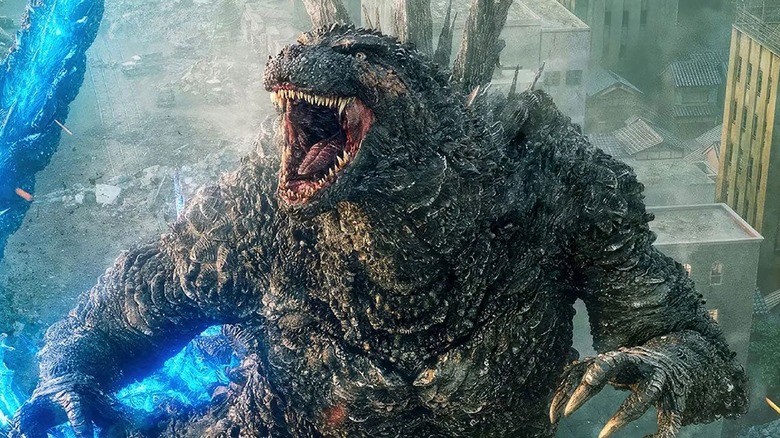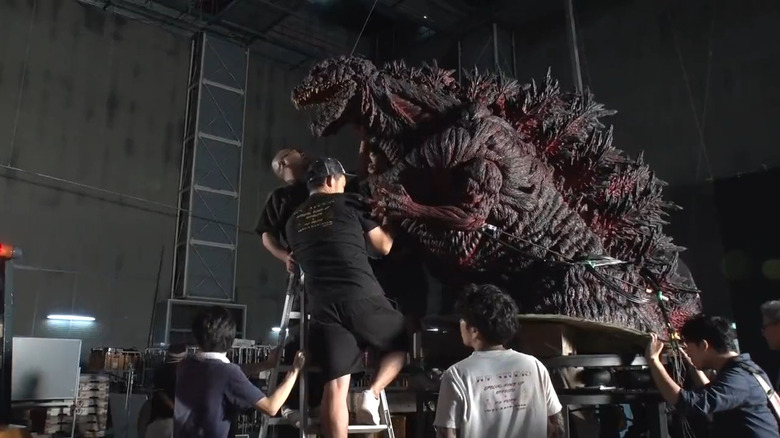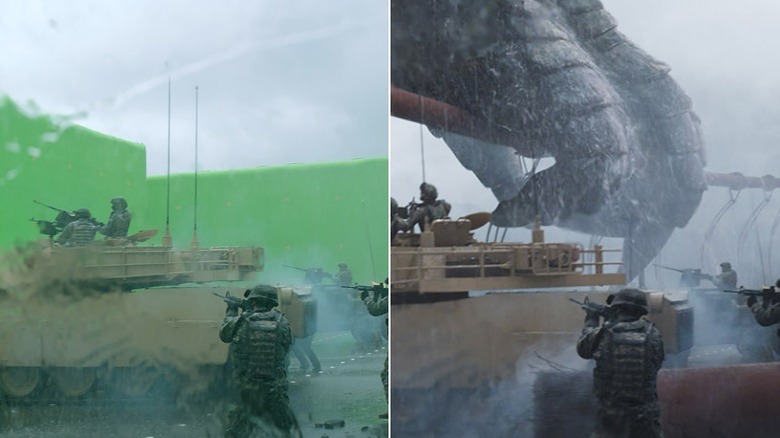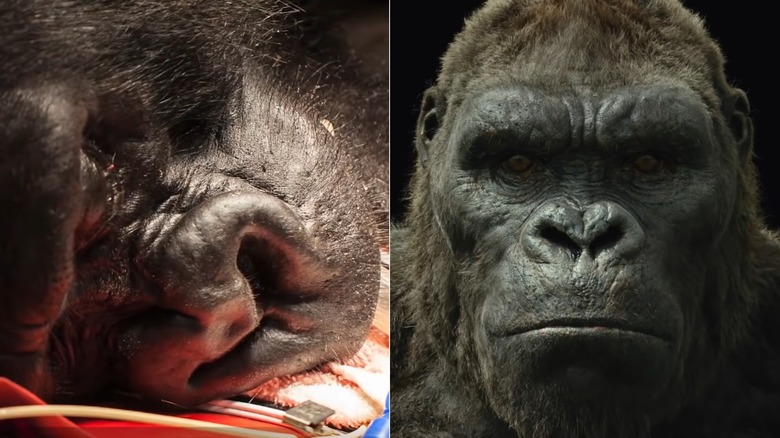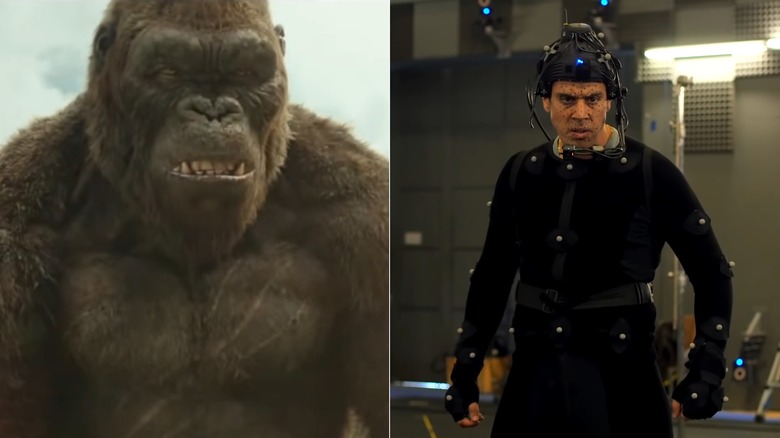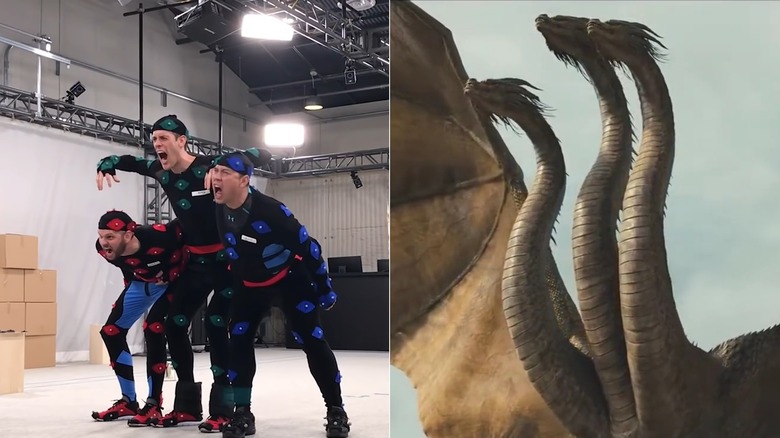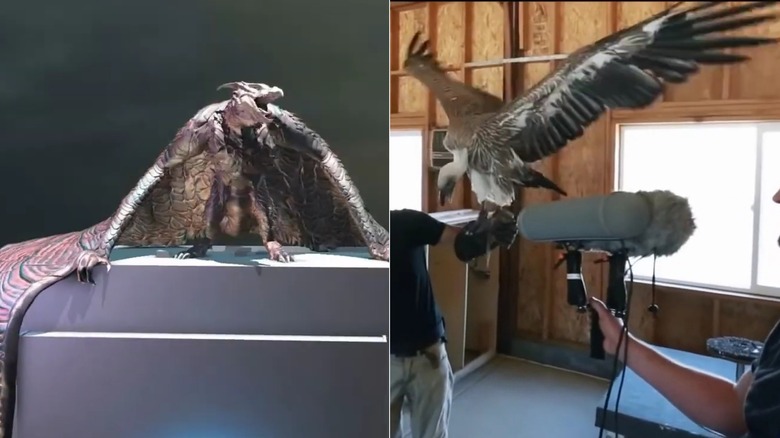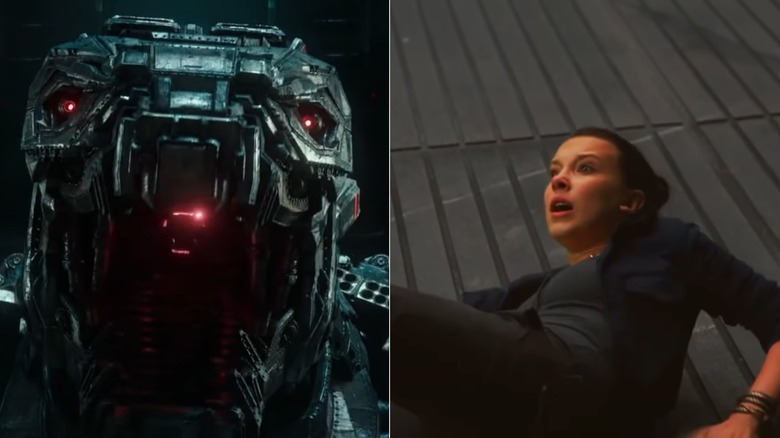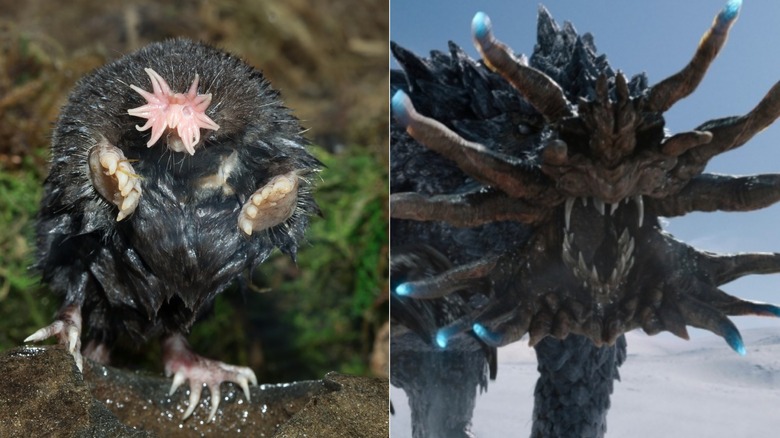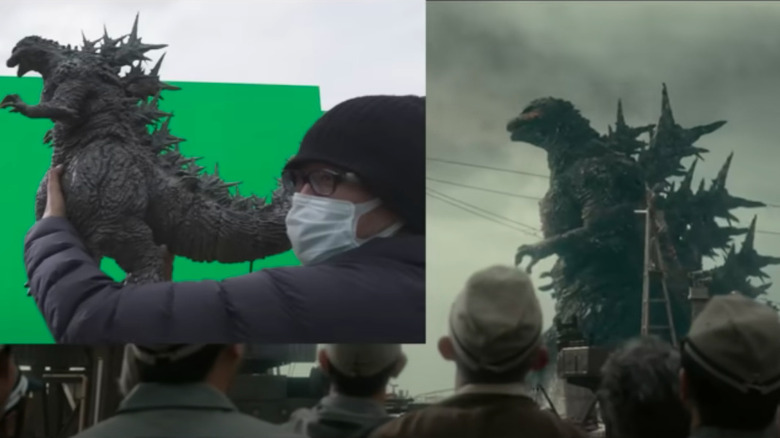What The Godzilla Movies Look Like Before Special Effects
Godzilla is the most famous monster in movie history, so coming up with a transcendent design in the modern day is no easy feat. The original 1954 film used special effects that were groundbreaking at the time: a man in a massive suit knocking over miniature sets. The scaly monster in that picture changed filmmaking for good, and contemporary movies are still trying to conjure up that same level of awe.
The 2010s saw a resurgence of Godzilla and his monster kin, as the American MonsterVerse series revived the classic blockbuster form. In Japan, the Reiwa era ushered in modern classics like "Shin Godzilla" and "Godzilla: Minus One." Though these films may differ in story and style, they all build upon their predecessors, creating bigger, stronger, and more technically advanced creatures than ever before.
How do these monsters come to life? A lot of CGI, extensive green screen backgrounds, and a few guys running around in skintight bodysuits. If you've ever wondered what these movies look like before the special effects are finished, you're in the right place. It's time to take a peek behind the curtain.
Godzilla goes from puppet to CGI (Shin Godzilla)
Toho Studios, the company that created Godzilla back in the 1950s, has a long history of using practical effects with great success. In fact, the Japanese Godzilla films used an actor in a Godzilla suit for all their movies up until "Godzilla: Final Wars" in 2004. In 2016's "Shin Godzilla," VFX artists used CGI to create the iconic monster, though an earlier version of Godzilla was created in puppet form. As shown in this behind-the-scenes video, the large puppet came to life using remote controls and a weighted pulley system. This puppet wasn't put to work in the final product, but it's an impressive creation nonetheless.
Though co-director Hideaki Anno previously worked on several Tokusatsu shows, which use live-action practical effects, CGI was the name of the game for "Shin Godzilla." Atsuki Sato, the VFX supervisor for the film, shared that none of the animatronics they created made it into the final product.
They did have an actor do motion capture acting for Godzilla, which helped bring the creature to life. Instead of basing Godzilla on real animals, the director wanted Godzilla to "have the texture of rubber," which harkens back to the material of some of the early Godzilla suits. All in all, this CGI Godzilla appears for 18 minutes and 8 seconds, which accounts for 15% percent of the movie.
Attack on the Golden Gate Bridge (Godzilla, 2014)
The first entry in the MonsterVerse series, Gareth Edwards' "Godzilla," defines the look of these contemporary monsters. The film follows a soldier (Aaron-Taylor Johnson) trying to get home to his family amidst a battle between Godzilla and another group of ancient monsters. VFX supervisor Guillaume Rocheron was tasked with bringing the movie's massive action set pieces to life, including Godzilla's destruction of famous American landmarks.
For example, one scene in the film depicts the military trying to hold off Godzilla as he attacks the Golden Gate Bridge (an event henceforth known as "G-Day"). First, the team had to digitally recreate San Fransisco, so Godzilla could then stomp around and destroy it. A group of photographers traveled around the city and took reference photos that VFX artists used to create digital panoramas. Next, the compositing team added lighting and other effects like smoke to the urban environment.
The second step was shooting the attack on the city, using this digital rendering as a backdrop. Rocheron explained that Edwards wanted to film the fight sequence as if they were really in the environment, using shots that would be possible in the middle of the action. This means many of the camera angles embody a human point of view to illustrate the massive scale of the action. While the actors in the frame were shooting at an imaginary enemy in front of a green screen, Rocheron and his team made sure they stayed on top of continuity.
Taking inspiration from the zoo for Kong: Skull Island
Though King Kong is an American creation and Godzilla a Japanese one, the two monsters now exist in the same world via the MonsterVerse series, so let's give the spotlight to the giant ape for a little bit. "Kong: Skull Island" is the second film in the franchise and King Kong's first appearance in this modern universe. The design of King Kong is somewhat more intuitive than that of Godzilla, because he has a clear analog in the animal kingdom, and the artists involved in the film used this real-life connection as inspiration.
In a behind-the-scenes video, creature model supervisor Kris Costa shared that the team traveled to a local zoo to see gorillas up close. They took a series of macro photographs that showed all of the details of a gorilla's face and body. Lana Lam, another creature model supervisor on the film, explained that Costa "really focused on putting almost half the detail in the head and face."
Creating the hair was also an enormous undertaking. Lead fur groomer Gaelle Morand noted that there were over 17 million hairs on Kong's body and that the team took great pains to add elements like matting and clumping in the fur. Though King Kong is a wild, dangerous animal, these finely tuned details go a long way in encouraging the viewer to connect with him on an emotional level.
It's all in Kong's eyes
The first half of the equation for creating King Kong is his connection to the gorillas in our world, and the second half is his connection to humanity. In order to make King Kong sympathetic to the audience, the producers of the film had to imbue him with some kind of emotion. As animation supervisor Scott Benza put it, "Without the luxury of him being able to speak or make traditional facial expressions, we were limited to having to create all of that emotional range just through Kong's eye performance."
King Kong's emotions were also portrayed by actor Toby Kebbell, who recorded facial performances that VFX artists mapped onto Kong. Benza shared that "it was really important to convey that Kong was a living, breathing, and most importantly thinking creature," and Kebbell's performance helped communicate these unvoiced thoughts.
Brie Larson, one of the film's stars, revealed her strategy for tapping into emotion and acting against a character who wasn't there in the flesh. She likened Kong to an elephant, an enormous, powerful creature who could crush you but doesn't, and recalled the fear and awe she experienced the first time she encountered one. Kebbell and Larson never acted in the same room together, and both had the difficult job of performing without their scene partner nearby.
Creating a three-headed monster for Godzilla: King of Monsters
As the MonsterVerse grows, so does the variety of new and terrifying creatures that appear in the films. In "Godzilla: King of Monsters," Godzilla faces off against his most formidable enemies in the monster kingdom: King Ghidorah, who matches Godzilla in strength and size. "That's the Superbowl to a Godzilla fan," O'Shea Jackson Jr. said of their battle.
King Ghidorah is a mashup of ancient mythologies. Director Michael Dougherty explained that he derives from Greek myth but has the look of a creature from Eastern mythology. Millie Bobby Brown mentioned that she finds King Ghidorah to be the scariest of the monsters "because each head has a character and a different personality and a different roar."
To create the distinction that Brown details, three performance capture artists took on the roles of Ghidorah's three heads. The performers were quite literally tied together, so that they would move in conjunction with one another but were still able to maneuver on their own. Dougherty described this strategy as "sort of the modern way of doing a man in a rubber suit." The image of these actors attached at the hip, covered in multicolored dots, and roaring at a man holding a camera looks pretty absurd, but the King Ghidorah you see in the film is nothing short of astonishing.
Designing Rodan, the King of the Skies
As if a three-headed dragon wasn't enough of a threat, Godzilla also goes head-to-head with Rodan, another flying monster. Director Michael Dougherty called him "The King of the Skies" because of his unparalleled ferocity. According to Matt Allsopp, a visual development supervisor on the film, one of the biggest challenges was making Rodan look different from other monsters in the series, particularly the MUTOs that appeared in 2014's "Godzilla."
Rodan is more bird-like than any of his monster relatives, and Allsopp revealed that one of their key references was the vulture. The artists took inspiration from the body language and the physical features of birds like vultures and hawks to create Rodan. As Allsopp put it, what made the design unique was Rodan's exterior, which is sort of like an outer shell that mirrors the volcano in which he had been hibernating for many years.
Real-life birds were also used to create Rodan's call. The team recorded owls, penguins, and an aggressive vulture named Steve. Dougherty's mom was even involved in the making of the film, as her habit of sending him videos of the cranes in her backyard contributed to Rodan's final sound. This sound design wound up being helpful to the actors, who didn't have much in the way of visual reference to base their performances on. As Vera Farmiga explained, though they couldn't see the monsters, "We had their battle cries. We had a lot of auditory stimulation."
Millie Bobby Brown vs Mechagodzilla in Godzilla vs Kong
Behind-the-scenes videos of these monster movies can give you a better sense of just how little the actors have to work with on set. Take the key scene in "Godzilla vs. Kong," where Millie Bobby Brown's character is being chased by the technological terror of Mechagodzilla. The scene takes place in a cavernous underground facility, though it was filmed in an empty, colorless room. In B-roll footage from the set, you can see Brown running across the room and falling on her marks, looking up towards the ceiling at, well, nothing.
There is one aspect of the scene that is practical, and that is the spaceship-esque hatch that Brown and the other characters run to for safety. The actors were able to jump into the hatch for real, where another set of cameras were waiting to capture their arrival. Shortly thereafter, the windows of the hatch are splattered with the guts of Skullcrawler, which the Mechagodzilla just eviscerated. These guts were also practical effects, shot out of cannons to mimic the Skullcrawler's violent death. After the actors filmed the scene, it was the VFX artist's turn to fill in the monsters and the digital backdrops.
The shaking bus on G-Day for Monarch: Legacy of Monsters
The Apple TV+ series "Monarch: Legacy of Monsters" is a continuation of the MonsterVerse in TV form. As in the other entries in the franchise, artists used CGI to design and bring to life the awe-inspiring monsters these characters face. However, there were several areas where the show's creators used practical effects to create a realistic environment. As special effects supervisor Paul Benjamin told Animation Magazine, "We had one airbag deck that we probably used on every episode from putting a bus on it to the rescue pod to a sand set."
The airbag deck allowed whatever was on top of it to shake from side to side or front to back and created a lot of the movements during monster attack scenes. This behind-the-scenes video shows lead actor Anna Sawai jumping out of the shaking school bus while filming the flashback G-Day sequence where Godzilla destroys the Golden Gate Bridge.
In an interview with Screen Rant, Sawai revealed that the G-Day sequence was the most difficult scene to shoot. She didn't yet know how to react to the famous tennis ball because it was early on in the filming process. Plus, it was wet and rainy, and Sawai was surrounded by children (her character is a teacher in the show), and she found it difficult to interact with them all at once. Being attacked by a giant monster in the middle of a famous landmark is no walk in the park!
Drawing from nature's strangeness for Monarch: Legacy of Monsters
Most viewers, whether fans of the franchise or not, are familiar with the legends of Godzilla and King Kong. On "Monarch: Legacy of Monsters," the producers wanted to expand this monster world even further, so they devised a new group of prehistoric creatures to terrorize the show's human characters. Some of the monsters were inspired by real-life animals with some pretty strange features.
As VFX supervisor Sean Konrad told Variety, co-creator Matt Fraction ordered his son to research the weirdest animals he could find and then write up a 250-word report about a new monster. The result? The Frost Vark, a terrifying arctic creature based on the star-nosed mole. "We'd grimace and squeal as we'd review a series of horrifying and bizarre insects, reptiles and more that felt like they were out of the brain of a twisted artist rather than mother nature," Konrad said of the brainstorming sessions.
Even though monsters like the Frost Vark are so far removed from anything we've seen in the real world, the VFX artists still wanted to imbue them with some semblance of emotion. "A great way to give more complexity to the creature is to give it a second to react to things between moments of rage," Konrad told AWN.com. For example, there is a brief moment when the Frost Vark calmly watches the flare Kentaro (Ren Watabe) throws before going after him again. Co-creator Chris Black wanted to make sure "it didn't feel like a nonstop rage factory."
Godzilla in high-definition in Godzilla Minus One
Takashi Yamazaki's spellbinding "Godzilla Minus One" is the first Godzilla film to ever receive an Oscar nomination, and for good reason. On a meager budget of only $15 million, the VFX is stunning and packs an emotional punch. Yamazaki, the director, writer, and visual effects supervisor, told Variety about the importance of the final battle scene where the ad-hoc battalion destroys Godzilla. "We wanted to make it a sacred, almost religious moment, where you see the light rays and imagine what this moment would be like" he said.
Yamazaki and his team used the best CG available to make Godzilla look as photoreal as possible. "We were able to increase the resolution of the scales, for example, and make them feel really, really sharp and give it this aggressive texture," he said of Godzilla's new look. All in all, the modest team of 35 artists completed the film with only 610 VFX shots. For comparison, "Avengers: Endgame" used 2,500 VFX shots (and had a budget of $365 million). There was also a practical model used for reference in creating the digital version of Godzilla, as shown in a featurette from Toho.
Over 100 of these VFX shots were water shots, a number that is "almost unheard of" in Japan, said visual effects director Kiyoko Shibuya. "People were saying, 'We don't know what you guys are thinking or doing. You must be out of your mind to make that many,'" Shibuya joked. The scene when Godzilla sinks into the ocean was one of the most difficult to create, and in a nice moment of synchronicity, harkens back to the Oxygen Destroyer weapon from the original 1954 film.
